Characteristic
Short description
Time-dependent data, like road blockings for trucks at night, can be considered as relevant for further functionality when diverse time constraints or time scenarios are met.
Use
For xRoute and xDima, time-relevant data may influence the results of a route![]() A route corresponds to a path of a vehicle through the underlying transport network. The main attributes of a route are the distance and the time that the vehicle travels along the path. calculation,
just like any other road segment data, but additionally its influence may depend on timing constraints.
For xMap, all relevant road data is drawn as usual, whereas non-relevant elements are shown in a grayed color.
A route corresponds to a path of a vehicle through the underlying transport network. The main attributes of a route are the distance and the time that the vehicle travels along the path. calculation,
just like any other road segment data, but additionally its influence may depend on timing constraints.
For xMap, all relevant road data is drawn as usual, whereas non-relevant elements are shown in a grayed color.
Detailed Description
Properties, for example those of a road segment, can be defined as time-dependent or not. In case of time-independency,
the property will be always valid (or relevant) in time. A typical example represents the blocking of a road according to physical limitations
like the vehicle![]() The term vehicle describes what is being routed or planned for. Vehicles are used in route calculation, distance matrix calculation and effectively also in tour planning. In route calculation, vehicle properties like overall size, weight and speed are in focus. In tour planning, it is vehicle properties like capacity and availability.
Commonly a vehicle is motorized, like a truck - including its trailer or a car. However also a bike or even a pedestrian are included in this definition. height, which is indeed independent of time.
The term vehicle describes what is being routed or planned for. Vehicles are used in route calculation, distance matrix calculation and effectively also in tour planning. In route calculation, vehicle properties like overall size, weight and speed are in focus. In tour planning, it is vehicle properties like capacity and availability.
Commonly a vehicle is motorized, like a truck - including its trailer or a car. However also a bike or even a pedestrian are included in this definition. height, which is indeed independent of time.
In contrast, time-dependent properties provide additionally one or more time intervals, for which the actual property is only valid. The blocking of a road for trucks can be restricted to 9 p.m. until 6 a.m. of the next day, for example. This time-dependent blocking is oftenly used nearby hospitals. The time interval is expressed according to the GDF time domains definition and it is compared against one of the following options, so-called time consideration scenarios, to be indeed relevant:
- Snapshot time consideration: A reference time, i.e. a dedicated point in time, is used for determination of a property's relevance. If this time is covered by the time domain of the time-dependent property, this property is regarded as relevant.
- Time span consideration: Besides a reference time, additionally a duration is used to define a time span. A property is only considered as relevant, if its time domain covers the whole time span completely.
- Exact time consideration: This time consideration scenario is dedicated to xRoute and relates to all road properties (with their time domains) according the 'walk' along the route: By setting the reference time at start or end of the route, for each used route segment a dedicated reference time can be associated, namely the time when this segment is traveled on. This individual reference time is compared against the segment's time domain.
- Optimistic consideration: All time-dependent restrictions are ignored. Only maximum speeds of every segments of the route are taken into computation.
- Multiple travel times consideration: This time consideration scenario is dedicated to xDima. It is considered that travel times change over the day.
- No time consideration: All time-dependent properties are regarded as non-relevant.
For route calculation, road segments can be configured with additional features, which may influence the course of the resulting route. In context of time consideration, only relevant segment features can do this. To distinguish relevant features from non-relevant ones, a grayed color is used for the non-relevant features during rendering of a map.
Time consideration scenarios can be defined independently for routing and rendering. In order to take into account time-dependent data, the optional route request field timeConsideration should be used. Please note that for rendering, the time consideration scenario should be configured with other fields (see Feature Layer Attributes) to get the expected map content.
Examples for time-dependent data are Feature Layers (PTV_SpeedPatterns, PTV_TruckAttributes,...) and toll data. The following tabs will concentrate on the details of the individual scenarios.
This scenario ignores all time-dependent information. Because the time domains cannot be compared against some time constraints, it seems to be more reasonable to use only time-independent features.
Rendering with Feature Layers
Features which are not time-dependent are displayed in the normal way whereas time-dependent features are grayed. For example time-dependent speeds or waiting times are completely grayed out as well as time-dependent truck attributes (e.g. blockings, bonus and malus). In addition there exists the map option showOnlyRelevantByTime. If activated then the time-dependent features are hidden instead of only grayed.
Toll calculation
Time-dependent toll costs are ignored. For basic toll data a result limitation is sent if the calculated route passes through a time-dependent toll.
Routing with Feature Layers
Only those features which are not time-dependent are evaluated. Time-dependent Feature Layer data representing speeds or waiting time is ignored. Speeds are evaluated according to their nc/sc classification.
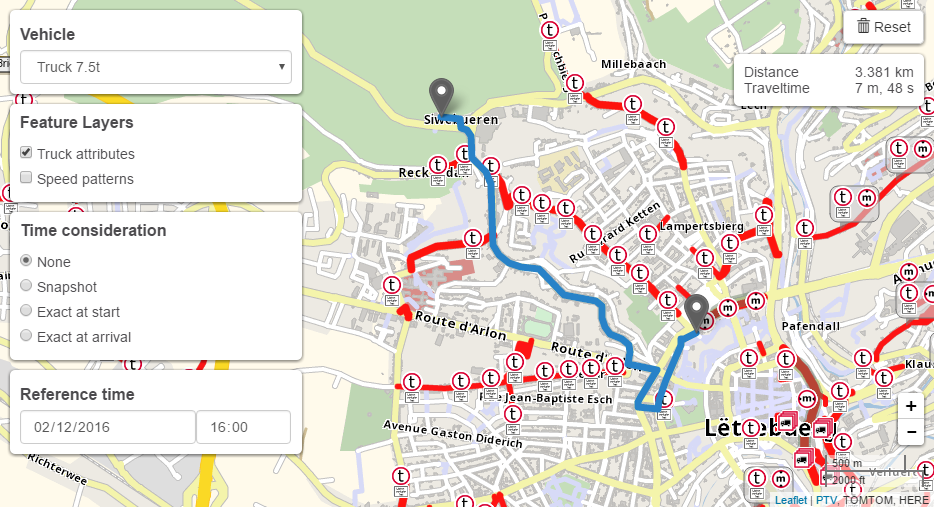
Use snapshot time consideration scenario for approximated route calculations: for this scenario it is mandatory to set a reference time which is applied to all time-dependent segment properties. Note that route calculation might be faster compared to exact time consideration.
Rendering with Feature Layers
Time-dependent Feature Layer data is evaluated at reference time. So, the rendering of the map is exactly a snapshot of the situation (traffic, blocked routes) at reference time. Time-dependent features which are not relevant at the specified reference time are grayed out. In addition there is the map option showOnlyRelevantByTime. If activated, then the time-dependent features which are not relevant are hidden instead of only grayed.
Toll calculation
All toll costs are evaluated exactly at reference time. With increasing route length the possibility that the wrong toll prices are selected rises. Therefore the price can differ when compared to the result of the toll costs calculated with time consideration mode exact.
Routing with Feature Layers
All time-dependent features are evaluated exactly at reference time. In contrast to the exact calculation the error increases the longer the calculated route is.
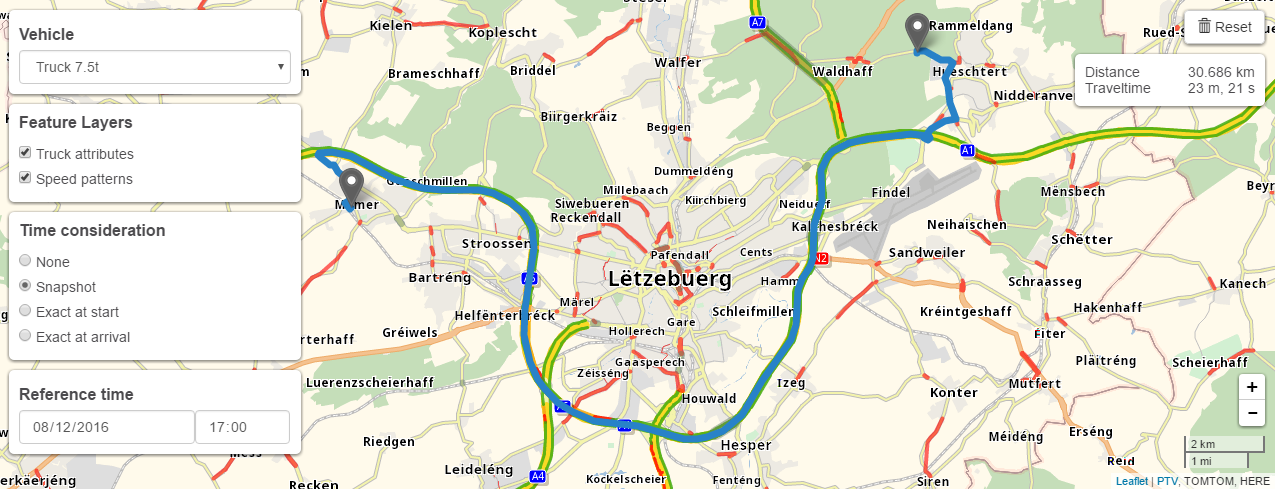
Use time span consideration scenario for route calculations which take only long-term features (e.g. long lasting construction sites) into account. In this scenario it is mandatory to set a reference time and a duration. Besides all time-independent features, time-dependent features are considered for routing only if their time domain is completely covered by the (long-term) time span starting at reference time. The default value for the duration of the long-term time span is 48h.
Rendering with Feature Layers
Time-dependent Feature Layer data is evaluated for a time span starting at reference time and lasting for a certain duration. Time-dependent features with time domains not covering completely the time span are not relevant and, as a consequence, are grayed out. In addition there is the map option showOnlyRelevantByTime. If activated, then the time-dependent features which are not relevant are hidden instead of only grayed.
Toll calculation
All toll costs are evaluated exactly at reference time (same as snapshot time consideration scenario). With increasing route length the possibility that the wrong toll prices are selected rises. Therefore the price can differ when compared to the result of the toll costs calculated with time consideration mode exact.
Routing with Feature Layers
All time-dependent features are evaluated for a time span starting at reference time and lasting for a certain duration. Time-dependent features with time domains covering completely the time span are regarded as relevant and will be used to calculate the best route. Otherwise, this information is ignored.
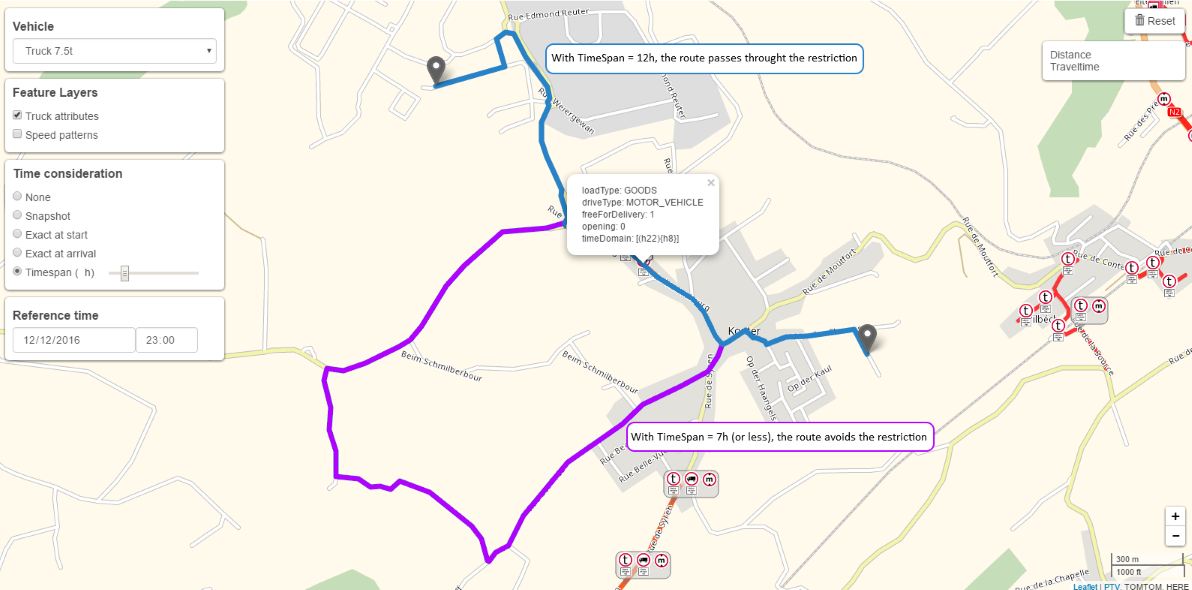
Use exact time consideration scenarios for real-time route calculation. Calculation with exact time consideration results in the most likely travel time and toll cost. In this scenario it is mandatory to set a reference time. It is possible to specify the reference time as starting time or the expected time at arrival.
Please note that routing calculation might be slower compared to the other scenarios because no optimization can be used.
Rendering with Feature Layers
In exact time consideration scenarios every road segment is evaluated at the time it is reached during propagation in the routing algorithm. Due to this routing internal known information, all time-dependent data cannot be rendered in these scenarios. If one of these scenarios is chosen for rendering, an exception will be thrown.
Toll calculation
Time-dependent toll costs are evaluated exactly at the time a road segment is reached.
Routing with Feature Layers
All results are dependent of the chosen reference time, because all time-dependent features are evaluated exactly at the time a road segment is reached (see picture below). Please note that exact time consideration is only applicable with single route calculation in combination with Conventional Routing. Thus, using exact time consideration to calculate high-performance routing networks or distance matrices will always result in an exception.
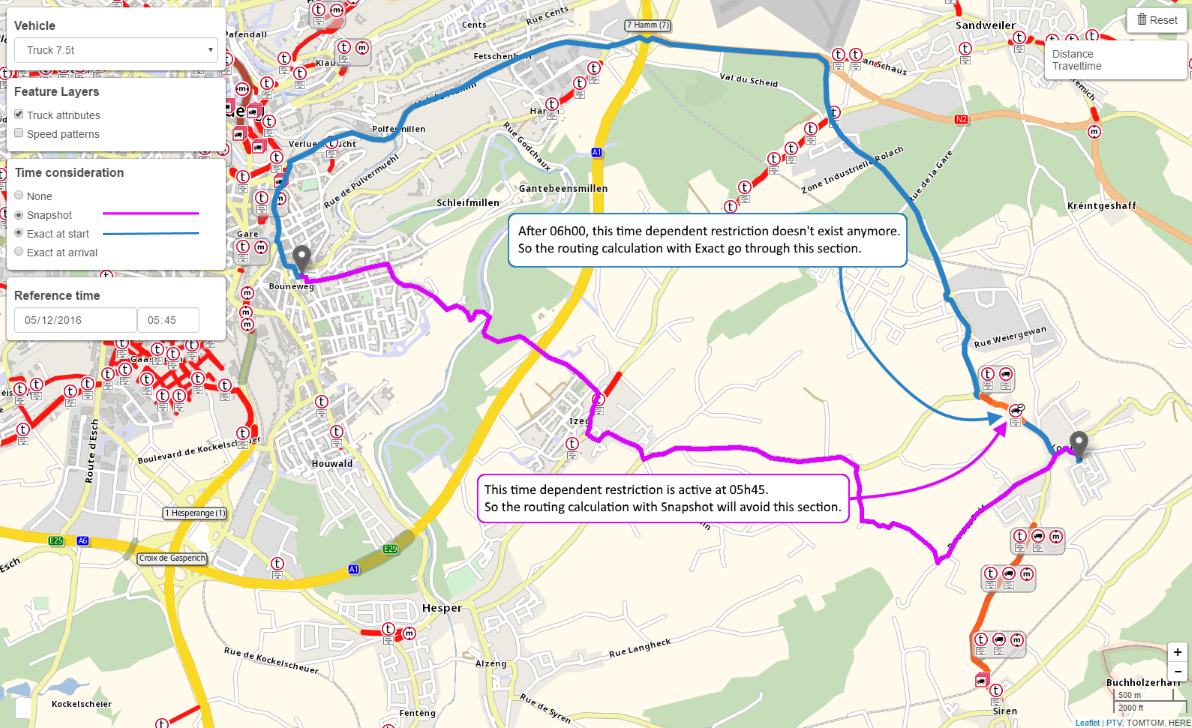
Using Simplified Route Calculation
The field simplifiedRouteCalculation
is only relevant for xRoute. It should be set only in a route request
with at least one of the feature layers PTV_SpeedPatterns or PTV_TruckSpeedPatterns activated and no PathWaypoint.
When enabled, this will speed up the route calculation but be aware that it might lead to slightly suboptimal routes.
This field will be ignored if set to true in a route request with no PTV_SpeedPatterns or PTV_TruckSpeedPatterns feature layers or with PathWaypoint.
Use optimistic time consideration scenario for calculating the lower bound for travel times. This scenario is independent of the chosen reference time. Only features which are not time-dependent are taken into account during route calculation. In other words, it is assumed that all time-dependent blockings are open (or ignored) when they are reached (invalid at evaluation time during the algorithm).
Rendering with Feature Layers
Features which are not time-dependent are displayed in the normal way whereas time-dependent features are grayed. The optimistic level of service is also displayed.
Toll calculation
Time-dependent toll costs are ignored. For basic toll data a result limitation is sent if the calculated route passes through a time-dependent toll.
Routing with Feature Layers
In this scenario Feature Layers representing speed data are not disabled, but the maximum of the available speeds over all layers and time slots is used. Feature Layers which represent waiting times are taken into account with their minimal waiting time over all time slots. Like this it can be guaranteed that speed data (e.g., speed patterns, incidents, nc/sc) used for travel time calculation of a certain road segment is always higher or equal than the calculated speed for the same road segment in the other scenarios.
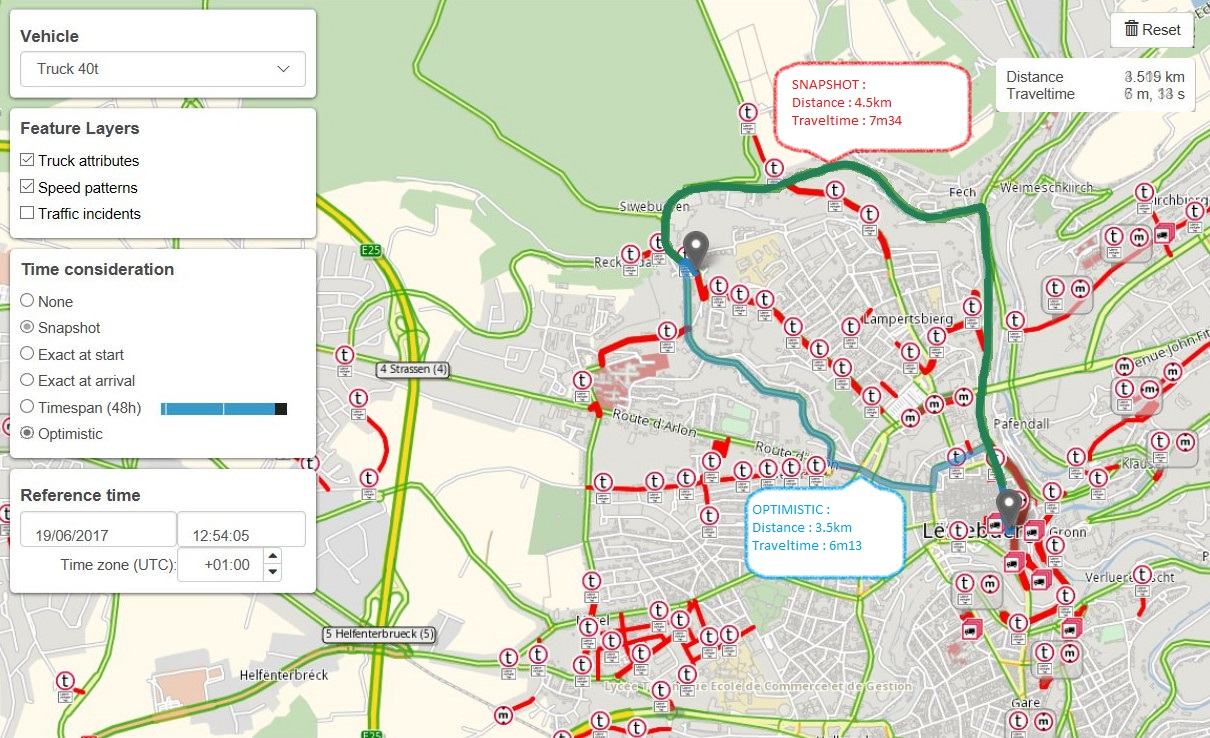
This time consideration scenario is dedicated only to xDima and xData (not for xMap and xRoute) for a Multiple Travel Times Distance Matrix and its (optional) corresponding high-performance routing network.
Use multiple travel times consideration scenario for calculating the travel times using several starting dates along a horizon (maximum duration of 24 hours).
Rendering with Feature Layers
This time-consideration scenario cannot be rendered, xMap will throw an exception.
Toll calculation
This time-consideration scenario is not supported by the toll calculation, xRoute will throw an exception.
Routing with Feature Layers
For this scenario it is mandatory to set a Multiple Travel Times Distance Matrix with a horizon.
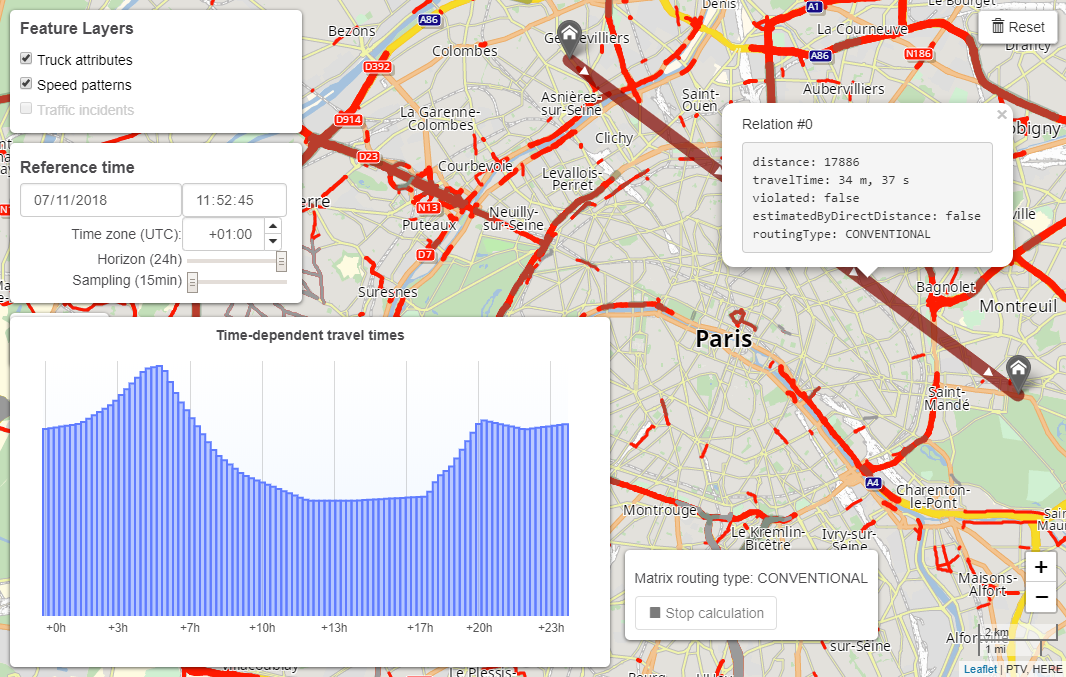
Use toll only time consideration scenario to also evaluate time-dependent toll tariffs: for this scenario it is mandatory to set a reference time which is applied to all toll data.
Rendering with Feature Layers
This time-consideration scenario cannot be rendered, xMap will throw an exception.
Toll calculation
All toll costs are evaluated exactly at reference time. With increasing route length the possibility that the wrong toll prices are selected rises. Therefore the price can differ when compared to the result of the toll costs calculated with time consideration mode exact.
Routing with Feature Layers
Only those features which are not time-dependent are evaluated. Time-dependent Feature Layer data representing speeds or waiting time is ignored.
Good to know
Use now by default
In order to visualize the current traffic situation or to calculate the estimated time of arrival when starting the route now, just leave the reference time empty. PTV xServer will use the current time (now) as the reference time independent of the time zone in which the server is located.
Usually points in time in the response will have the same UTC offset as the reference time in the response. If the reference time is empty points in time in the response will be in UTC.
Tile requests with an empty reference time may be cached by the browser so that the map image will not change even though the traffic situation changes. To make sure that this will not happen, set the reference time explicitly to the current time.
Related topics
| Technical Concept | GDF time domains |
| Technical Concept | Time Zones |
| Showcase | Calculate toll costs |
| Showcase | Consider time-dependent Feature Layer |
| Showcase | Consider Multiple Travel Times Matrices |
| Integration Sample | Calculate toll |
| Integration Sample | Calculate route metrics |